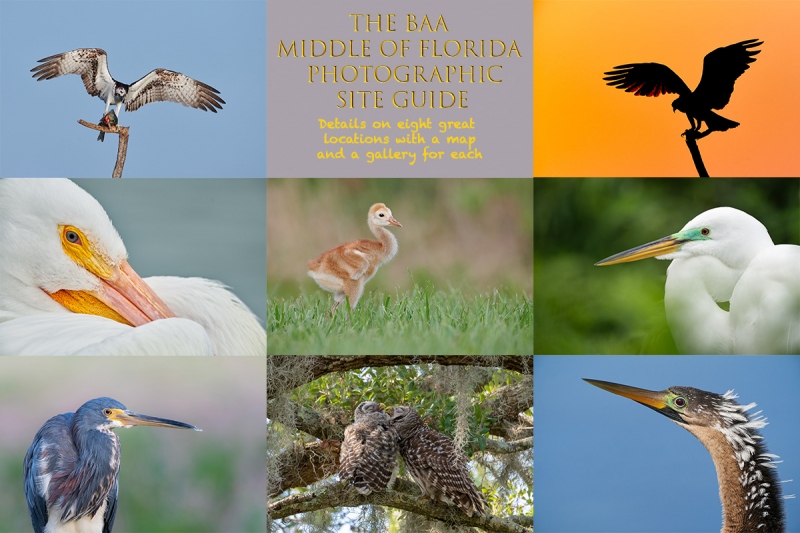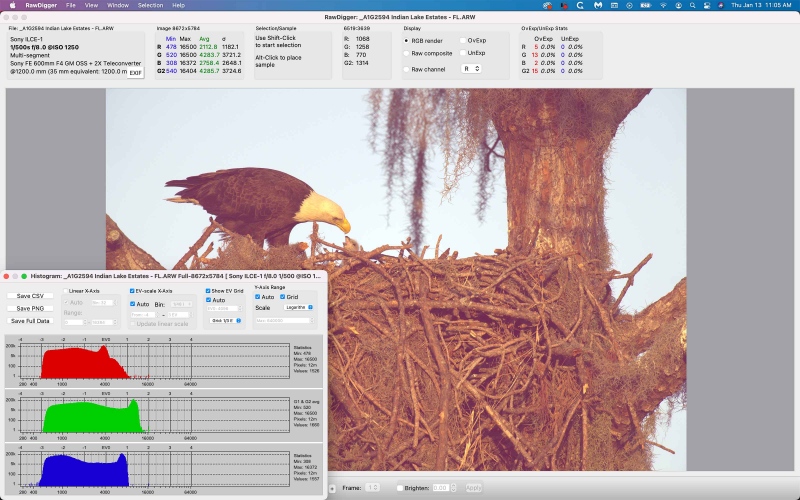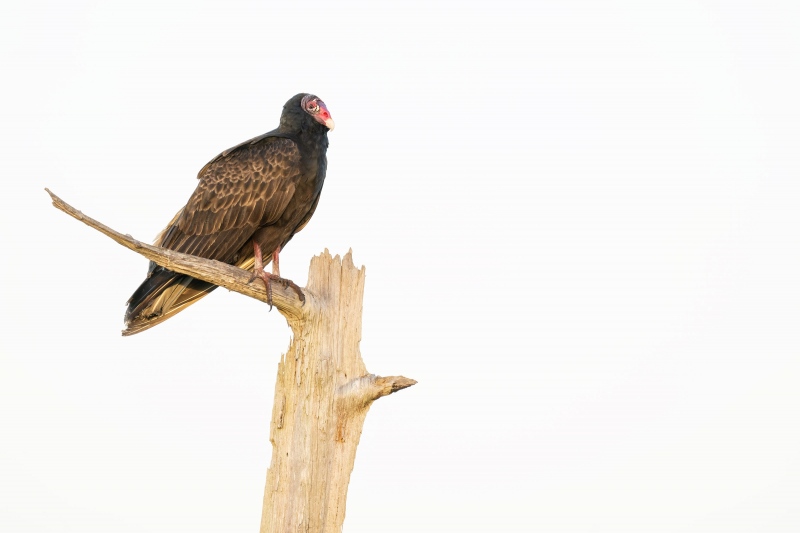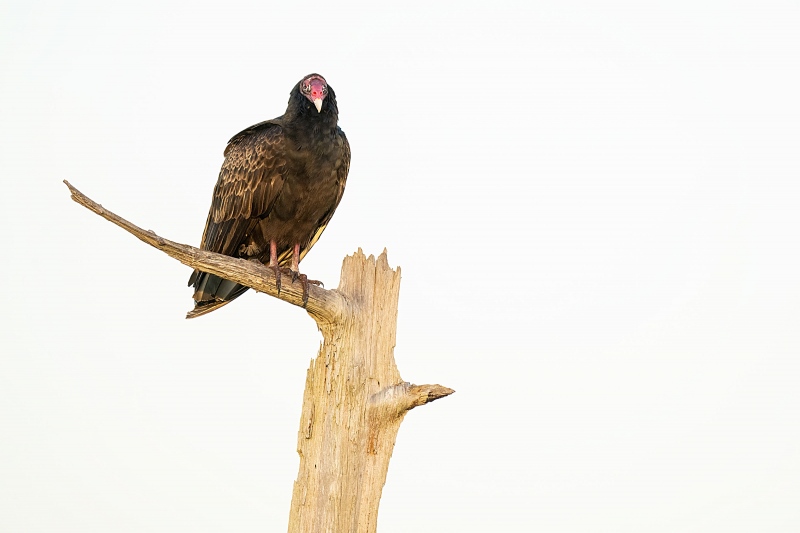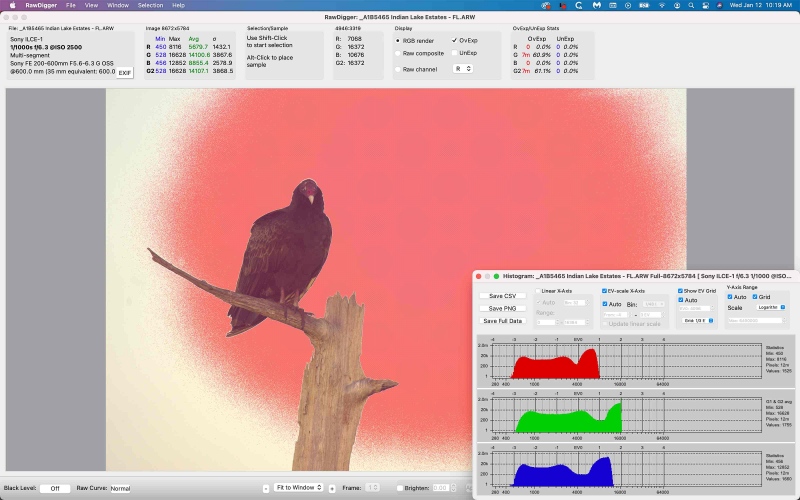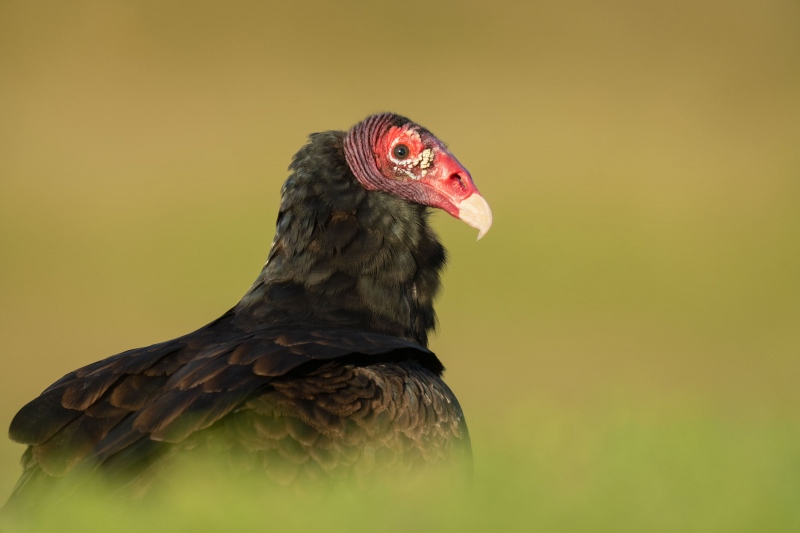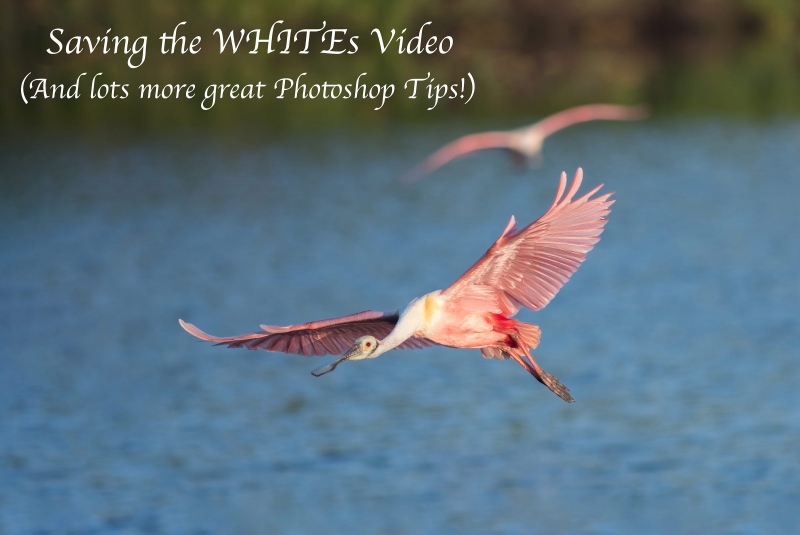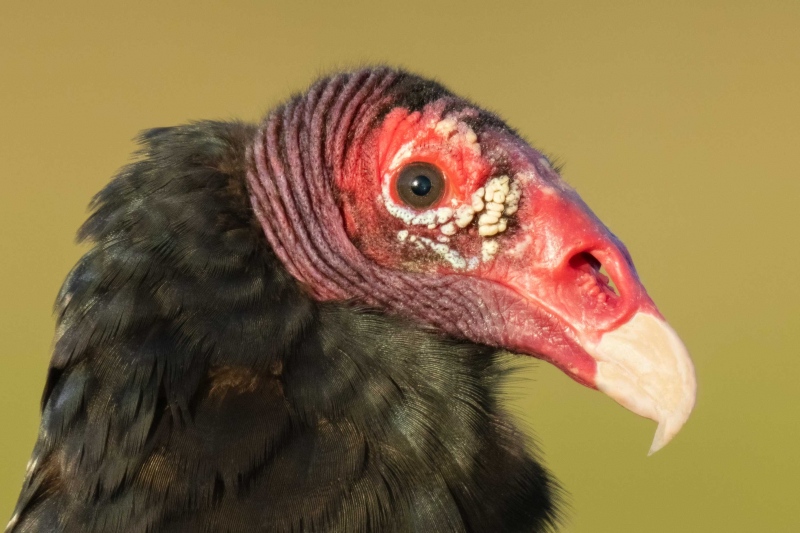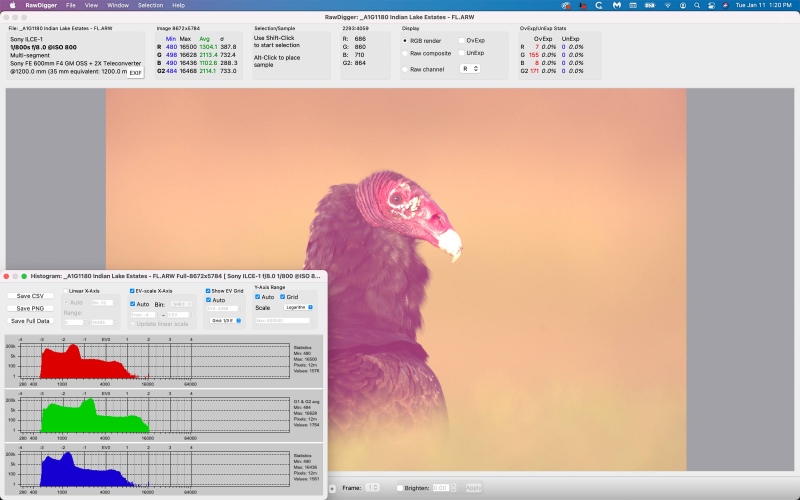January 14th, 2022 What’s Up?
Me, in the air at 11:35am today (if everything goes as planned), headed for one of my favorite places on the planet, San Diego, CA. Today is Friday 14 January and the weather does not matter as it is a travel day for me.
I did enjoy a short photo session on Thursday and had one half-way decent chance that resulted in today’s featured image (along with and lots of lessons for the boys and girls below). Even though I was all packed I could not resist going down to the lake for sunset. I was saved from having to unpack and re-pack my Think Tank rolling bag by a strong west wind.
Right-hand man Jim Litzenberg and I are in my SUV early headed for MCO as I finish this blog post. Wherever you are, and whatever you are doing, I hope that you too have a great day. This blog post took about an hour to prepare and makes 65 consecutive days with a new one.
Please remember that you can find some great photo accessories (and necessities, like surf booties!) on Amazon by clicking on the Stuff tab on the orange/yellow menu bar above. On a related note, it would be extremely helpful if blog-folks who, like me, spend too much money on Amazon, would get in the habit of clicking on the Amazon logo link on the right side of each blog post when they shop online. As you might expect, doing so will not cost you a single penny, but would be appreciated tremendously by yours truly. And doing so works seamlessly with your Amazon Prime account.
Please remember that if an item — a Delkin flash card, or a tripod head — for example, that is available from B&H and/or Bedfords, is also available in the BAA Online Store, it would be great, and greatly appreciated, if you would opt to purchase from us. We will match any price. Please remember also to use my B&H affiliate links or to save 3% at Bedfords by using the BIRDSASART discount code at checkout for your major gear purchases. Doing either often earns you free guides and/or discounts. And always earns my great appreciation.
Sony Alpha 1 Bodies in Stock at Bedfords/free card offer!
Steve Elkins of Bedfords let me know recently that he had several Sony a1 bodies in stock. If one of them has your name on it, please click here and be sure to enter the BIRDSASART coupon code check the box for free shipping to enjoy free Second Day Air Fed-Ex. Right now, in lieu of the 3% credit refunded to the card you used for your purchase, you will receive a Sony 160GB CFexpress Type A TOUGH Memory Card, a $399.99 value!
Brand New and As-Good-As-Ever Bedfords BAA Discount Policy
Folks who have fallen in love with Bedfords can now use the BIRDSASART coupon code at checkout to enjoy a post-purchase, 3% off-statement credit (excluding taxes and shipping charges) on orders paid with a credit card. The 3% credit will be refunded to the card you used for your purchase. Be sure, also, to check the box for free shipping to enjoy free Second Day Air Fed-Ex. This offer does not apply to purchases of Classes, Gift Cards, or to any prior purchases.
Money Saving Reminder
Many have learned that if you need a hot photo item that is out of stock at B&H and would like to enjoy getting 3% back on your credit card along with free 2nd Day Air Fed-Ex Air shipping, your best bet is to click here, place an order with Bedfords, and enter the coupon code BIRDSASART at checkout. If an item is out of stock, contact Steve Elkins via e-mail or on his cell phone at (479) 381-2592 (Central time). Be sure to mention the BIRDSASART coupon code and check the box for Free Shipping. That will automatically upgrade to free 2nd Day Air Fed-Ex. Steve has been great at getting folks the hot items that are out of stock at B&H and everywhere else. The waitlists at the big stores can be a year or longer for the hard to get items. Steve will surely get you your gear long before that. For the past year, he has been helping BAA Blog folks get their hands on items like the SONY a 1, the SONY 200-600 G OSS lens, the Canon EOS R5, the Canon RF 100-500mm lens, and the Nikon 500mm PF. Steve is personable, helpful, and eager to please.
Important Note
As an Amazon Associate, I earn a small percentage when you purchase from Amazon after using any of the Amazon links on the blog (including the logo-link immediately above). My link works with Amazon Prime and using it will not cost you a single cent. Huge thanks, BTW 🙂
Please Remember Also
Please, if you enjoy and learn from the blog, remember to use one of my two affiliate programs when purchasing new gear. Doing so just might make it possible for me to avoid having to try to get a job as a Walmart greeter and will not cost you a single penny more. And if you use Bedfords and remember to enter the BIRDSASART code at checkout, you will (still!) save 3% on every order and enjoy free second-day air shipping. In these crazy times — I lost about fifty thousand dollars in income due to COVID 19 — remembering to use my B&H link or to shop at Bedfords will help me out a ton and be greatly appreciated. Overseas folks who cannot order from the US because of import fees, duties, and taxes, are invited to help out by clicking here to leave a blog thank you gift if they see fit.


Gear Questions and Advice
Too many folks attending BAA IPTs and dozens of photographers whom I see in the field and on BPN, are–out of ignorance–using the wrong gear, especially when it comes to tripods and more especially, tripod heads… Please know that I am always glad to answer your gear questions via e-mail. If you are desperate, you can try me on my cell at 863-221-2372. Please leave a message and shoot me a text if I do not pick up.
|
|
|
This image was created on 13 January 2022 down by the lake near my home in Indian Lake Estates. Standing as tall as possible just outside my SUV, I used the no-longer available GIT 304L/Levered-Clamp FlexShooter Pro-mounted BLUBB-supported Sony FE 600mm f/4 GM OSS lens, the Sony FE 2.0x Teleconverter, and The One, the Sony Alpha 1 Mirrorless Digital Camera.. ISO 1250. The exposure was determined perfectly by Zebras with ISO on the rear wheel: 1/500 sec. at f/8 (wide open) in Manual mode. AWB at 7:45:49am on a sunny morning.
Tracking: Spot S AF/C with Bird-Eye/Face Detection performed perfectly. Click on the image to enjoy the high-res version.
Image #1: Bald Eagle adult feeding small chick (full frame at 1200mm)
|
Chick-let Suspicion Confirmed!
Having watched the eagle lying low in the nest for more than a few weeks, I figured that she was incubating her clutch. On Tuesday, it looked as if she were feeding young, but I’d could not see over the edge of the nest. On Wednesday, I was pretty sure that I saw the head of a very small chick. Then finally on Thursday morning I witnessed and photographed an adult eagle feeding a chick that is probably a week or so old. I took a few frames from the vehicle working off the BLUBB but wanted to get a bit higher, so I moved the car back a bit, added the 2X TC, and worked off the tripod.
If I were not headed for San Diego I would be checking the nest each morning with my super-tall tripod and my tall sturdy, tall stepladder in the back of my vehicle (if needed). Getting two or even three feet higher would be a big advantage. The nest is relatively low and fairly open; as the chick or chicks grow to fledging, there should be some great photography in store at ILE for the next few months. Not to mention the Sandhill Cranes and chicks! Folks who own The Middle of Florida Site Guide are invited to e-mail for detailed directions to the nest along with some photo tips. Please include proof-of-purchase. Others my purchase the guide (see below) and then request the eagle nest info.
|
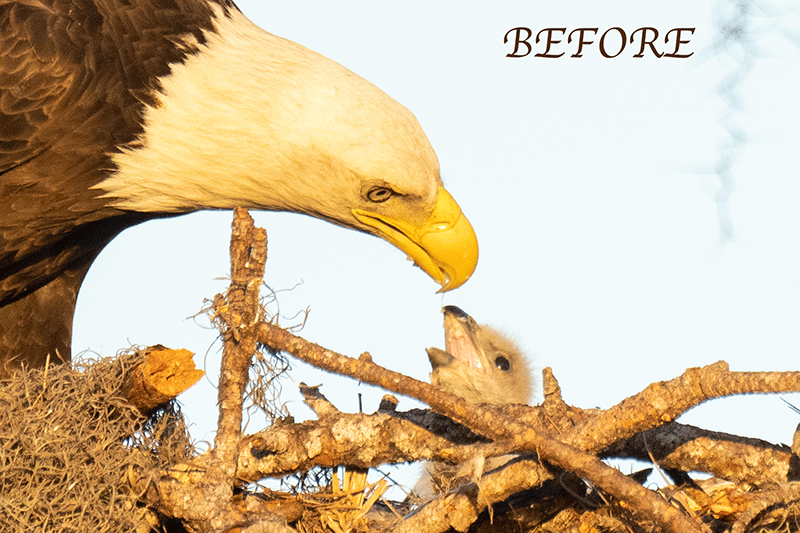
|
Image #1A: A highly-cropped animated GIF for the Bald Eagle feeding tiny chick (full frame at 1200mm) image
|
The Image Optimization
I converted the raw file with Adobe Camera Raw and brought the image into Photoshop. I did not like the YELLOW cast, a result of the sweet early morning light. I used the techniques detailed in the Saving the Whites (and lots more!) Video to restore the detail in the single bright area of the bird’s head. I reduced the YELLOW saturation for the whole image, and further reduced it after selecting the head. The latter technique is also detailed in the Saving the Whites (and lots more!) Video.
In addition, I did not like the branch sticking into the adult eagle’s neck. I shortened that stick using a series of Quick Masks each refined with the addition of a Regular Layer Mask. You can enjoy the before and after views of the head in the animated GIF above. Note that I removed the YELLOW cast from the heads of both the adult and the chick and also that I lightened the eagle’s now properly WHITE head.
|
|
The BAA Middle of Florida Photographic Site Guide
You can purchase your copy here in the BAA Online Store.
|
The BAA Middle of Florida Photographic Site Guide
126 pages, 87 photographs by Joe Przybyla and Arthur Morris.
The PDF for this e-Guide is an electronic download sent via e-mail.
Purchase your copy here in the BAA Online Store.
I had thought about doing a guide to some of the great but little-known photo hotspots around central Florida for about a decade, but those plans never came to fruition. I met Joe online in the Avian Forum at BirdPhotographer’s.Net about two years ago. Joe’s photography has improved tremendously over the past few years; he credits the BAA blog, my books and PDFs, and his participation on BPN. The one thing that I learned right from the get-go about Joe is that he is a hard and tenacious worker, always striving to improve his skills and to grow his knowledge base. As he knew of more than a few good spots in central Florida, I broached the idea of us doing a photographic site guide that covered many of the little-known photographic hotspots from Brandon to Lakeland to Joe Overstreet Road to Indian Lake Estates (my Florida home for the past 20 years or so). After more than many, many dozens of hours of effort, The BIRDS AS ART Middle of Florida Photographic Site Guide is now a reality. Thanks to Joe’s wife Dottie for her review of our writing. We all learned once again that writing is a process, a back and forth process. All thanks to the white pelicans of Lakeland. Here are the locations that are detailed in this e-Guide:
- Indian Lake Estates: Sandhills Cranes with chicks and colts, lots of vultures, and Ospreys up the kazoo!
- Gatorland, Kissimmee: Learn to make great images of wading birds in a cluttered rookery.
- The Brandon Rookery: Great for nesting Wood Storks, Great Egrets, and more.
- Circle Bar B Reserve, Lakeland: Here you will find a great variety of avian subjects in a great variety of habitats.
- Lake Morton, Lakeland: There are lots of silly tame birds here including and especially American White Pelican during the colder months.
- Lake Mirror, Lakeland: Tame Anhingas, Limpkins, and a zillion White Ibises at times.
- West Lake Parker, Lakeland: Here you will have a chance for two difficult birds, Snail Kite, and Purple Gallinule.
- Joe Overstreet Road, Kenansville: Crested Caracara, meadowlarks, Loggerhead Shrike, and much more on the fenceposts and barbed wire.
Each location includes a map, a detailed description of the best spots, best season, light and time of day instructions, the expected species, and an educational and inspirational gallery that is designed to open your eyes as to the possibilities.
You can purchase a copy here in the BAA Online Store.
|
|
Image #1B: The RawDigger screen capture for the Bald Eagle feeding tiny chick (full frame at 1200mm) image
|
Dead-Solid Perfect!
Images where the G channel gets 2/3rds of the way from the 8000 to the 16000 line are perfect exposures. Images where the G channel gets right up to the line are dead-solid perfect. With 35 Ov-Exp pixels out of 51,000,000 today’s featured image is somewhere between perfect and dead-solid perfect. It is likely that that at the few Ov-Exp pixels are in the specular highlight in the adult bird’s eye.
RawDigger — not for the faint of heart …
Nothing has ever helped me learn to create perfect exposures to the degree that RawDigger has. I think that many folks are reluctant to learn that most of their images are underexposed by one or more full stops and that highlight warnings in Photoshop, Lightroom, Capture One, and your in-camera histogram are completely bogus as they are based on the embedded JPEGs. Only your raw files tell the truth all the time. Heck, I resisted RawDigger for several years … Once you get over that feeling, RawDigger can become your very best exposure friend no matter what system you are using. On the recent IPTs and In-the-Field sessions, we have demonstrated that fact. Convincingly.
The RawDigger (pink) Adapted Histogram
In the RawDigger e-Guide, you will learn exactly how to set up the Adapted “pink” RawDigger Histogram and how to use it to quickly and easily evaluate the exposure or raw file brightness of images from all digital cameras currently in use. RawDigger was especially helpful to me when I struggled with R5 exposures and when I learned my new camera body, the Sony Alpha a1.
|
|
RawDigger e-Guide with Two Videos
|
The RawDigger e-Guide with Two Videos
by Arthur Morris with Patrick Sparkman
The RawDigger e-Guide was created only for serious photographers who wish to get the absolute most out of their raw files.
Patrick and I began work on the guide in July 2020. At first, we struggled. We asked questions. We learned about Max-G values. We could not figure out why the Max G values varied by camera system. IPT veteran Bart Deamer asked lots of questions that we could not answer. We got help from RawDigger creator Iliah Borg. We learned. In December, Patrick came up with an Adapted Histogram that allows us to evaluate the exposures and raw file brightness for all images created with all digital camera bodies from the last two decades. What we learned each time prompted three complete beginning-to-end re-writes.
The point of the guide is to teach you to truly expose to the mega-Expose-to-the-Right so that you will minimize noise, maximize image quality, best utilize your camera’s dynamic range, and attain the highest possible level of shadow detail in your RAW files in every situation. In addition, your properly exposed RAW files will contain more tonal information and feature the smoothest possible transitions between tones. And your optimized images will feature rich, accurate colors.
We teach you why the GREEN channel is almost always the first to over-expose. We save you money by advising you as to which version of RawDigger you need. We teach you how to interpret the Max G values for your Canon, Nikon, and SONY camera bodies. It is very likely that the Shock-your-World section will shock you. And lastly — thanks to the technical and practical brilliance of Patrick Sparkman — we teach you a simple way to quickly and easily evaluate your exposures and raw file brightness using an Adapted RawDigger histogram.
The flower video takes you through a session where artie edits a folder of images in Capture One while checking the exposures and Max-G values in RawDigger. The Adapted Histogram video examines a series of recent images with the pink histograms and covers lots of fine points including and especially how to deal with specular highlights. The directions for setting up the Adapted Histogram are in the text.
If we priced this guide based on how much effort we put into it, it would sell it for $999.00. But as this guide will be purchased only by a limited number of serious photographers, we have priced it at $51.00. You can order yours here in the BAA Online Store.
Typos
With all blog posts, feel free to e-mail or to leave a comment regarding any typos or errors.
January 13th, 2022 What’s Up?
Wednesday morning was close to a bust photographically. I did see another pair of cranes copulating and I spotted a Purple Gallinule in the marsh just to the north of the pier after my less-than-inspiring blur session. It was cloudy most of the day, but the sun broke through just after 5:00pm so I headed down to the lake as there was a nice wind from the east. But there were lots of clouds. Thinking that my chances were somewhere between Slim and None, I brought the laptop so that I could work on this blog post. And did. Unfortunately, None was the victor — the sun ducked behind a cloud and then quickly disappeared for good.
Today is Thursday 13 January 2022, packing day. I leave for San Diego early on Friday. The forecast for the morning is for solidly cloudy with a breeze from the northeast. I will likely head down to the pier for some blurs and then check on the eagle nest. Then I need to get to work packing. Wherever you are, and whatever you are doing, I hope that you too have a great day. This blog post took about an hour to prepare and makes 64 consecutive days with a new one.
|
|
|
This image was created on 11 January 2022 at Indian Lake Estates. Standing outside of my SUV, I used the hand held Sony FE 200-600mm f/5.6-6.3 G OSS lens (at 600mm), and The One, the Sony Alpha 1 Mirrorless digital camera. ) ISO 1250. Exposure determined via Zebras with ISO on the rear dial: 1/400 sec. at f/6.3 (wide open) in Manual mode. AWB at 7:45:06am on a barely sunny morning.
Click on the image to enjoy a high-res version.
Image #1: Turkey Vulture on The Perch II, facing to the right
|
A Strange Morning
Monday had been a strange morning. It was cold with a brisk wind from the northwest. I walked out onto the pier with the big lens in one hand and the tripod in the other. There were dozens of Turkey Vultures on the pier railing. I had set up without a TC and the a1 was set up for blurs. So when the vultures took off and some of them landed on the railing a bit farther out on the pier, I made a few images. One of those turned out to be pretty cool. You will see it here at some point; it is entitled No Room at the Inn. I got to my favorite morning blur spot halfway out on the pier and saw a load of Cattle Egrets in the relatively distant marsh. As nothing was taking flight and I was freezing, I went back to the car and grabbed my bright yellow Emperor Penguin expedition parka. Again the vultures were on the railing with lots more on both sides of the pier. As it did not look as if any birds would be leaving the roost anytime soon I grabbed the 200-600 with my second a1 and set up for blurs. I went upwind of the vultures in hopes of making some pleasing blurs. I tried but that was about it.
Then the sun came over the big cloud in the east. There had been a vulture on The Perch, so I doubled back and was surprised to see that it was still there. I was glad that it did not fly off at my careful approach. I made some images and left the bird where I had found it. With my RawDigger education, I can always get the exposures very close to perfect especially with subjects that I know well. None-the-less, I am always experimenting to see if I can determine the difference between perfect and dead-solid perfect exposures in the field. With RawDigger you are constantly learning.
It is nice to see that after six months of inactivity, several species of birds have been using The Perch fairly regularly for the past few weeks.
|
|
|
This image was created on 11 January 2022 at Indian Lake Estates. Standing outside of my SUV, I used the hand held Sony FE 200-600mm f/5.6-6.3 G OSS lens (at 600mm), and The One, the Sony Alpha 1 Mirrorless digital camera. ) ISO 2500. Exposure determined via Zebras with ISO on the rear dial: 1/1000 sec. at f/6.3 (wide open) in Manual mode. AWB at 7:45:42am on a barely sunny morning.
Click on the image to enjoy a high-res version.
Image #2: Turkey Vulture on The Perch II, facing the camera
|
Your Call
Which is the stronger image? Which pose do you like best? Why? Which is the more elegant photograph?
|
|
Image #2A: RawDigger screen capture for the Turkey Vulture on The Perch II, facing the camera image
|
White Sky/Dark Subject
In white sky/dark subject situations, you must over-expose the sky to come up with a good exposure for the dark subject. I did just that here to the tune of 7,000,000 Ov-Exp pixels. I could have actually gone a bit lighter. Note the beautiful detail on the vulture’s black breast.
RawDigger — not for the faint of heart …
Nothing has ever helped me learn to create perfect exposures to the degree that RawDigger has. I think that many folks are reluctant to learn that most of their images are underexposed by one or more full stops and that highlight warnings in Photoshop, Lightroom, Capture One, and your in-camera histogram are completely bogus as they are based on the embedded JPEGs. Only your raw files tell the truth all the time. Heck, I resisted RawDigger for several years … Once you get over that feeling, RawDigger can become your very best exposure friend no matter what system you are using. On the recent IPTs and In-the-Field sessions, we have demonstrated that fact. Convincingly.
The RawDigger (pink) Adapted Histogram
In the RawDigger e-Guide, you will learn exactly how to set up the Adapted “pink” RawDigger Histogram and how to use it to quickly and easily evaluate the exposure or raw file brightness of images from all digital cameras currently in use. RawDigger was especially helpful to me when I struggled with R5 exposures and when learned my new camera body, the Sony Alpha a1.
|
|
RawDigger e-Guide with Two Videos
|
The RawDigger e-Guide with Two Videos
by Arthur Morris with Patrick Sparkman
The RawDigger e-Guide was created only for serious photographers who wish to get the absolute most out of their raw files.
Patrick and I began work on the guide in July 2020. At first we struggled. We asked questions. We learned about Max-G values. We could not figure out why the Max G values varied by camera system. IPT veteran Bart Deamer asked lots of questions that we could not answer. We got help from RawDigger creator Iliah Borg. We learned. In December, Patrick came up with an Adapted Histogram that allows us to evaluate the exposures and raw file brightness for all images created with all digital camera bodies from the last two decades. What we learned each time prompted three complete beginning to end re-writes.
The point of the guide is to teach you to truly expose to the mega-Expose-to-the-Right so that you will minimize noise, maximize image quality, best utilize your camera’s dynamic range, and attain the highest possible level of shadow detail in your RAW files in every situation. In addition, your properly exposed RAW files will contain more tonal information and feature the smoothest possible transitions between tones. And your optimized images will feature rich, accurate color.
We teach you why the GREEN channel is almost always the first to over-expose. We save you money by advising you which version of RawDigger you need. We teach you how to interpret the Max G values for your Canon, Nikon, and SONY camera bodies. It is very likely that the Shock-your-World section will shock you. And lastly — thanks to the technical and practical brilliance of Patrick Sparkman — we teach you a simple way to quickly and easily evaluate your exposures and raw file brightness using an Adapted RawDigger histogram.
The flower video takes you through a session where artie edits a folder of images in Capture One while checking the exposures and Max-G values in RawDigger. The Adapted Histogram video examines a series of recent images with the pink histograms and covers lots of fine points including and especially how to deal with specular highlights. The directions for setting up the Adapted Histogram are in the text.
If we priced this guide based on how much effort we put into it, it would sell it for $999.00. But as this guide will be purchased only by a limited number of serious photographers, we have priced it at $51.00. You can order yours here in the BAA Online Store.
Typos
With all blog posts, feel free to e-mail or to leave a comment regarding any typos or errors.
January 12th, 2022 What’s Up?
The temperature at 7:00am on Tuesday here at ILE was 54°. With a brisk wind from the north by slightly west, it seemed like the coldest morning of the year (even though we had 48° about two weeks ago). IAC, once I was out on the pier, I walked back to the car to get my Emperor Penguin expedition parka. The day began with 201 blurs, all of those on a walk-around with the 200-600 G lens and an a1. I chased Turkey Vulture blurs while my big lens sat halfway out on the pier doing nothing at all. Once the sun came up, I had one very good chance with one very handsome TV on The Perch. Then more TVs on the knoll, and then the crane pair from yesterday’s blog post walked back up on the knoll! I prayed for a repeat copulation, but alas, that did not happen.
With a stiff north/northeast wind and some nice sky color, conditions at sunset were excellent. I think that I got some special White Ibis silhouettes.
Today is Wednesday 12 January 2022. The forecast for this morning is for partly cloudy with a light north/northeast wind. You can find me down by the lake early. Wherever you are, and whatever you are doing, I hope that you too have a great day. This blog post took more than 90 minutes to prepare and makes 63 consecutive days with a new one.
Please remember that you can find some great photo accessories (and necessities, like surf booties!) on Amazon by clicking on the Stuff tab on the orange/yellow menu bar above. On a related note, it would be extremely helpful if blog-folks who, like me, spend too much money on Amazon, would get in the habit of clicking on the Amazon logo link on the right side of each blog post when they shop online. As you might expect, doing so will not cost you a single penny, but would be appreciated tremendously by yours truly. And doing so works seamlessly with your Amazon Prime account.
Please remember that if an item — a Delkin flash card, or a tripod head — for example, that is available from B&H and/or Bedfords, is also available in the BAA Online Store, it would be great, and greatly appreciated, if you would opt to purchase from us. We will match any price. Please remember also to use my B&H affiliate links or to save 3% at Bedfords by using the BIRDSASART discount code at checkout for your major gear purchases. Doing either often earns you free guides and/or discounts. And always earns my great appreciation.
Sony Alpha 1 Bodies in Stock at Bedfords/free card offer!
Steve Elkins of Bedfords let me know recently that he had several Sony a1 bodies in stock. If one of them has your name on it, please click here and be sure to enter the BIRDSASART coupon code check the box for free shipping to enjoy free Second Day Air Fed-Ex. Right now, in lieu of the 3% credit refunded to the card you used for your purchase, you will receive a Sony 160GB CFexpress Type A TOUGH Memory Card, a $399.99 value!
Brand New and As-Good-As-Ever Bedfords BAA Discount Policy
Folks who have fallen in love with Bedfords can now use the BIRDSASART coupon code at checkout to enjoy a post-purchase, 3% off-statement credit (excluding taxes and shipping charges) on orders paid with a credit card. The 3% credit will be refunded to the card you used for your purchase. Be sure, also, to check the box for free shipping to enjoy free Second Day Air Fed-Ex. This offer does not apply to purchases of Classes, Gift Cards, or to any prior purchases.
Money Saving Reminder
Many have learned that if you need a hot photo item that is out of stock at B&H and would like to enjoy getting 3% back on your credit card along with free 2nd Day Air Fed-Ex Air shipping, your best bet is to click here, place an order with Bedfords, and enter the coupon code BIRDSASART at checkout. If an item is out of stock, contact Steve Elkins via e-mail or on his cell phone at (479) 381-2592 (Central time). Be sure to mention the BIRDSASART coupon code and check the box for Free Shipping. That will automatically upgrade to free 2nd Day Air Fed-Ex. Steve has been great at getting folks the hot items that are out of stock at B&H and everywhere else. The waitlists at the big stores can be a year or longer for the hard to get items. Steve will surely get you your gear long before that. For the past year, he has been helping BAA Blog folks get their hands on items like the SONY a 1, the SONY 200-600 G OSS lens, the Canon EOS R5, the Canon RF 100-500mm lens, and the Nikon 500mm PF. Steve is personable, helpful, and eager to please.
Important Note
As an Amazon Associate, I earn a small percentage when you purchase from Amazon after using any of the Amazon links on the blog (including the logo-link immediately above). My link works with Amazon Prime and using it will not cost you a single cent. Huge thanks, BTW 🙂
Please Remember Also
Please, if you enjoy and learn from the blog, remember to use one of my two affiliate programs when purchasing new gear. Doing so just might make it possible for me to avoid having to try to get a job as a Walmart greeter and will not cost you a single penny more. And if you use Bedfords and remember to enter the BIRDSASART code at checkout, you will (still!) save 3% on every order and enjoy free second-day air shipping. In these crazy times — I lost about fifty thousand dollars in income due to COVID 19 — remembering to use my B&H link or to shop at Bedfords will help me out a ton and be greatly appreciated. Overseas folks who cannot order from the US because of import fees, duties, and taxes, are invited to help out by clicking here to leave a blog thank you gift if they see fit.


Gear Questions and Advice
Too many folks attending BAA IPTs and dozens of photographers whom I see in the field and on BPN, are–out of ignorance–using the wrong gear, especially when it comes to tripods and more especially, tripod heads… Please know that I am always glad to answer your gear questions via e-mail. If you are desperate, you can try me on my cell at 863-221-2372. Please leave a message and shoot me a text if I do not pick up.
|
|
|
This image was created on 11 January 2022 down by the lake near my home in Indian Lake Estates. Working from the driver’s seat of my SUV, I used the BLUBB-supported Sony FE 600mm f/4 GM OSS lens, the Sony FE 2.0x Teleconverter, and The One, the Sony Alpha 1 Mirrorless Digital Camera.. ISO 800. The exposure was determined by Zebras with ISO on the rear wheel: 1/800 sec. at f/8 (wide open) in Manual mode. AWB at 8:32:13am on a sunny morning.
Tracking: Spot S AF/C with Bird-Eye/Face Detection performed perfectly. Click on the image to enjoy the high-res version.
Image #1: Turkey Vulture in suffused green heaven (1200mm)
|
How to Create Bird-in-Heaven Images
The trick to creating the bird-in-heaven look with a strip of out-of-focus color at the bottom of the frame is to find a situation where there is a small rise at least a few inches in front of the bird. When you focus on the bird, the foreground element, in this case the rise, will be rendered completely and pleasingly diffused. As the bird was on the far side of a small hill, the trick for me was to drive up the hill until I could see just the top half of the bird above the grass on the crest of the hill. Next, for this image, with the northwest wind, was getting the look-back head turn! I did that for this frame only and then the bird turned away from me and walked down the hill. One is all that it takes!
|
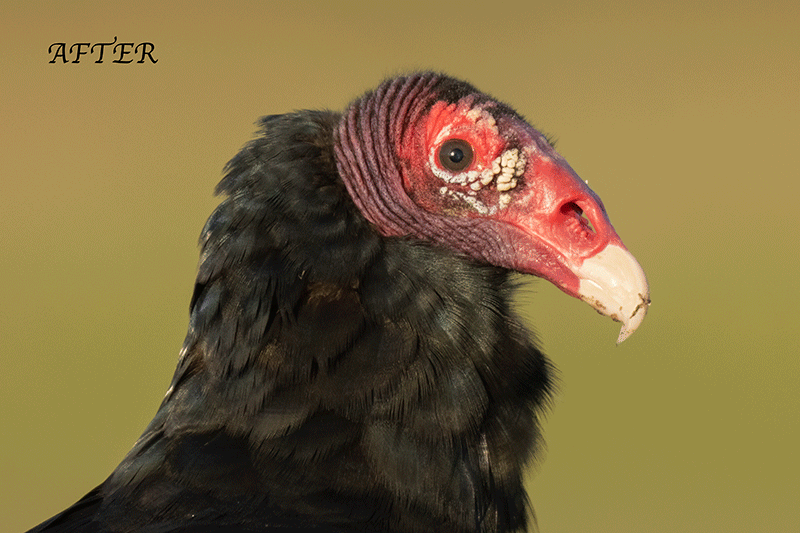
|
Image #1A: An Animated GIF showing the detail restored to the seemingly over-exposed bill tip
|
Before and After Saving the Whites
By exposing to the right to the max, you ensure getting maximum detail in the vulture’s dark and black feathers. Understand that the bill tip is not over-exposed — see the RawDigger screen capture at the bottom of this blog post. But while the bill is not over-exposed — the detail is all there in the digital file, we need to know how to restore that detail. The are several things to do in the raw conversion, and many additional steps to be done once the .TIF file is in Photoshop (or in Lightroom). You rarely need to use all of the techniques on a single image, but it surely helps to have them all at your disposal. All of them are detailed in the Saving the Whites (and lots more!) Video.
|
|
The Saving the WHITEs (and lots more!) Video image
|
The Saving the Whites (and lots more!) Video
My two biggest challenges when optimizing images are getting the BLUEs just right, and restoring detail to the WHITEs and highlights of properly exposed raw files. There are four things that I do to accomplish the latter. All are covered in detail in this 21+ minute video, along with a dirty trick to try if the first four do not work perfectly. Sit with me at my laptop as I teach you how to save the WHITEs. I begin with the raw conversions of two different raw files, first with the Snowy Owl image featured here, and then with Joe Usewicz’s spoonbill image that was featured in the Extraordinary Over-Exposed (?) Spoonbill/Saving the WHITEs Optimization blog post here.
In addition to learning how to save the WHITEs (in both images), you will learn how to expand canvas using the amazingly convenient Content-Aware Crop Tool, to set the White Balance (color temperature), to set the WHITE and BLACK points, see Digital Eye Doctor and RawDigger in action, learn to make a Color Range Selection, and lots more.
To purchase your copy of the Saving the Whites Video (and lots more!) video, you can send a PayPal for $37.00 to us at birdsasart@verizon.net, call Jim in the office at 863-692-0906 with your credit card in hand, or visit the item in the BAA Online store by clicking here.
|
|
Image #1C: Tight crop of the face of the Turkey Vulture in suffused green heaven (1200mm)
|
Amazing Sharpness and Detail at 1200mm
I continue to be stunned by the sharpness, image quality, and fine-feather detail of Sony Alpha 1 images, even those created at 1200mm. Even when working off the BLUBB. Note: while the BLUBB is by far the most stable beanbag ever created, a good tripod and head will always be a bit more stable. But not anywhere as convenient when using your car as a blind.
|
|
Image #1A: RawDigger screen capture for the Turkey Vulture in suffused green heaven (1200mm) image
|
Dead-Solid Perfect!
Images where the G channel gets 2/3rds of the way from the 8000 to the 16000 line are perfect exposures. Images where the G channel gets right up to the line are dead-solid perfect. With 341 Ov-Exp pixels out of 51,000,000 this is a dead-solid perfect exposure. Note: if you magnify the image you can see that all of the Ov-Exp pixels are in the specular highlight in the bird’s eye.
RawDigger — not for the faint of heart …
Nothing has ever helped me learn to create perfect exposures to the degree that RawDigger has. I think that many folks are reluctant to learn that most of their images are underexposed by one or more full stops and that highlight warnings in Photoshop, Lightroom, Capture One, and your in-camera histogram are completely bogus as they are based on the embedded JPEGs. Only your raw files tell the truth all the time. Heck, I resisted RawDigger for several years … Once you get over that feeling, RawDigger can become your very best exposure friend no matter what system you are using. On the recent IPTs and In-the-Field sessions, we have demonstrated that fact. Convincingly.
The RawDigger (pink) Adapted Histogram
In the RawDigger e-Guide, you will learn exactly how to set up the Adapted “pink” RawDigger Histogram and how to use it to quickly and easily evaluate the exposure or raw file brightness of images from all digital cameras currently in use. RawDigger was especially helpful to me when I struggled with R5 exposures and when I learned my new camera body, the Sony Alpha a1.
|
|
RawDigger e-Guide with Two Videos
|
The RawDigger e-Guide with Two Videos
by Arthur Morris with Patrick Sparkman
The RawDigger e-Guide was created only for serious photographers who wish to get the absolute most out of their raw files.
Patrick and I began work on the guide in July 2020. At first, we struggled. We asked questions. We learned about Max-G values. We could not figure out why the Max G values varied by camera system. IPT veteran Bart Deamer asked lots of questions that we could not answer. We got help from RawDigger creator Iliah Borg. We learned. In December, Patrick came up with an Adapted Histogram that allows us to evaluate the exposures and raw file brightness for all images created with all digital camera bodies from the last two decades. What we learned each time prompted three complete beginning-to-end re-writes.
The point of the guide is to teach you to truly expose to the mega-Expose-to-the-Right so that you will minimize noise, maximize image quality, best utilize your camera’s dynamic range, and attain the highest possible level of shadow detail in your RAW files in every situation. In addition, your properly exposed RAW files will contain more tonal information and feature the smoothest possible transitions between tones. And your optimized images will feature rich, accurate colors.
We teach you why the GREEN channel is almost always the first to over-expose. We save you money by advising you as to which version of RawDigger you need. We teach you how to interpret the Max G values for your Canon, Nikon, and SONY camera bodies. It is very likely that the Shock-your-World section will shock you. And lastly — thanks to the technical and practical brilliance of Patrick Sparkman — we teach you a simple way to quickly and easily evaluate your exposures and raw file brightness using an Adapted RawDigger histogram.
The flower video takes you through a session where artie edits a folder of images in Capture One while checking the exposures and Max-G values in RawDigger. The Adapted Histogram video examines a series of recent images with the pink histograms and covers lots of fine points including and especially how to deal with specular highlights. The directions for setting up the Adapted Histogram are in the text.
If we priced this guide based on how much effort we put into it, it would sell it for $999.00. But as this guide will be purchased only by a limited number of serious photographers, we have priced it at $51.00. You can order yours here in the BAA Online Store.
Typos
With all blog posts, feel free to e-mail or to leave a comment regarding any typos or errors.
|
|





